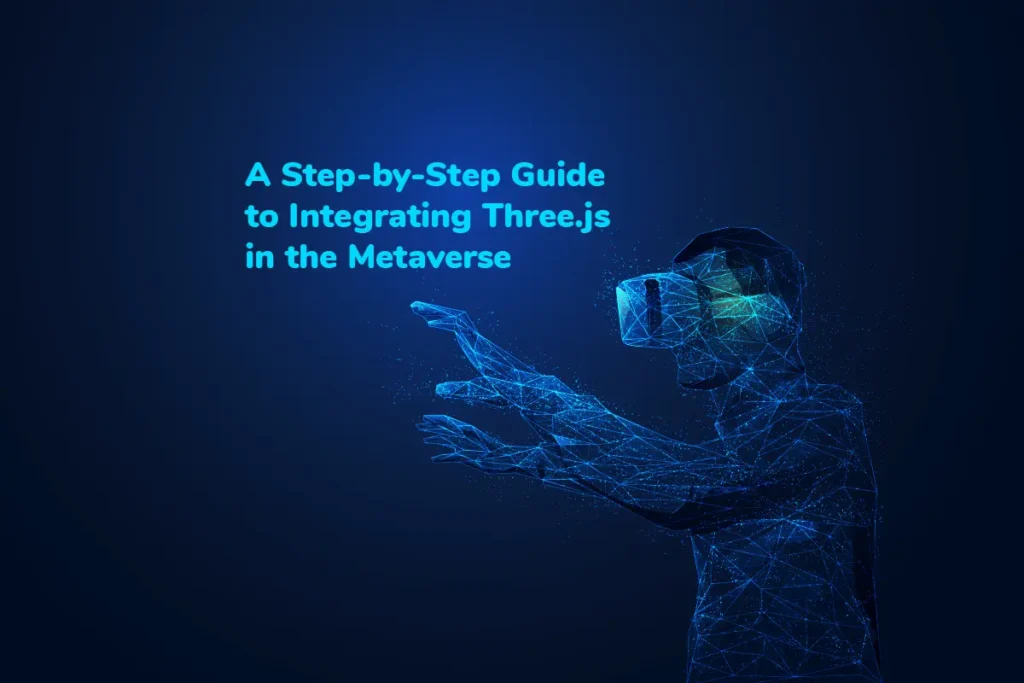What was once only a futuristic idea in science fiction, the Metaverse, is now becoming a real part of our daily digital interaction. This collective virtual shared space, birthed from a fusion of enhanced reality, real-time 3D graphics, AI, and high-definition video, embodies a digital cosmos brimming with user-generated content. The Metaverse transcends physical reality, cultivating immersive experiences with tremendous potential to transform entertainment, socialization, commerce, and education.
As the Metaverse landscape matures, tools such as Three.js find themselves at the heart of this evolution. This lightweight, agile JavaScript library streamlines the development and rendering of 3D graphics on the web, forming the backbone of the Metaverse’s infrastructure. Three.js, with its rich set of features and capabilities, Three.js enables developers to craft interactive virtual landscapes that are the lifeblood of the Metaverse.
Getting to Know Three.js
Three.js simplifies the development of 3D graphics by providing a more accessible interface for WebGL. Its vast array of features, including multiple renderers and comprehensive APIs, offers a powerful toolset for developers. Installation is straightforward, making it accessible for developers to create 3D web content.
Three.js: An Elevator Pitch
Three.js is a robust open-source JavaScript library that gives life to animated 3D computer graphics in a web browser. Its strength lies in its ability to simplify the intricacies of WebGL, thus providing developers with a more user-friendly interface to create 3D graphics swiftly.
The Toolbox: Three.js Features
A cornucopia of features sets Three.js apart. It supports multiple renderers like WebGL, CSS3D, and SVG and is compatible with a wide array of geometries and materials for detailed 3D modelling. Its scene graph embraces cameras, lights, and meshes, thus allowing developers to construct elaborate 3D scenes. Additionally, Three.js comes with APIs for animations, controls, and loaders, fortifying interactivity and user engagement within the Metaverse.
Booting Up: Three.js Installation and Setup
Getting started with Three.js is a breeze. You can fetch it from the official website or install npm. Once installed, linking the Three.js file in the HTML document paves the way for creating captivating 3D web content.
Easy Steps to Implement Metaverse Integration
The planning phase involves:
- Identifying project requirements.
- Assessing Metaverse platforms for compatibility.
- Designing user experience and interactions.
By clearly defining the project’s purpose and envisaging the desired user interactions, developers can build a foundation for their Metaverse environment.
Plotting the Course: Project Requirements and Goals
Before diving into integration, clarity of project requirements and goals is paramount. Consider the purpose of the virtual environment and the user interactions it should foster. Addressing these fundamental questions lays a solid foundation for the subsequent stages of development.
Surveying the Terrain: Metaverse Platforms and Compatibility
Next, gauge the compatibility of various Metaverse platforms with your project. Platforms differ in their hardware requirements, features, and usability. Select a platform that resonates with your project goals and technical boundaries.
Architecting Experiences: User Experience and Interactions
The design of user experience and interactions is the fulcrum around which the Metaverse revolves. A meticulously planned design promises a seamless user journey, intuitive controls, and meaningful interactions that create a memorable user experience.
Easy Steps to Create a Three.js Environment
Creating a Three.js environment begins with setting up an HTML canvas for rendering, configuring the scene, camera, and lighting, and adding objects and geometries. This step is crucial for bringing life to the Metaverse environment.
Setting the Stage: HTML Canvas for Metaverse Rendering
Kickstart the development by setting up an HTML canvas, the playground for your 3D graphics. Three.js employs this canvas to create the 3D content, marking the commencement of your Metaverse journey.
Orchestrating the Scene: Three.js Scene, Camera, and Lighting
Proceed to configure the scene, camera, and lighting. While the scene serves as a container for all 3D objects, the camera offers a perspective for viewing the scene, and lighting impacts how the 3D objects are perceived.
Breathing Life: Adding Objects and Geometry
Once the groundwork is laid, populate the scene with 3D objects. Three.js provides a myriad of predefined geometries, or you can create custom ones. By adding objects and geometries, you animate the Metaverse environment.
Understand Materials and Textures in Simple Terms
Materials and shaders play a pivotal role in determining the appearance of 3D objects in the Metaverse. Three.js offers functionalities for applying textures and colours to objects and creating custom shaders, adding a touch of personalization to the Metaverse.
The Aesthetic Details: Materials and Shaders
Materials and shaders in Three.js dictate the appearance of 3D objects. While materials define colour and texture, shaders, akin to programs, govern the interaction between objects and light, enabling the creation of realistic graphics.
Adding Color: Textures and Colors in Metaverse Objects
Textures and colours infuse vibrancy into the Metaverse. Apply varied textures to provide a distinct identity to your objects. With Three.js, you can create everything from simple colour alterations to intricate, multi-textured objects.
Beyond the Ordinary: Custom Shaders for Unique Visual Effects
For avant-garde visual effects, craft custom shaders with GLSL (OpenGL Shading Language). Custom shaders allow for pixel and vertex manipulation, facilitating unique visual effects that lend a dash of uniqueness to your Metaverse.
Implementing Interactivity
In the Metaverse, interactivity is crucial. Three.js provides:
- An inbuilt system for handling user inputs and interactions.
- Adding event listeners.
- Enabling object manipulations and animations.
These functionalities enhance user engagement and make the Metaverse come alive.
Navigating the Space: User Input and Interactions in the Metaverse
User input and interactions enhance the Metaverse’s immersive essence. These range from simple mouse clicks to complex gestures, all of which can be addressed using Three.js’s inbuilt event system.
Setting the Dynamics: Event Listeners and Controls
Three.js equips developers with APIs to add event listeners and controls. Event listeners respond to user actions like clicks or drag, and controls such as OrbitControls enable the camera’s position to adjust to user input.
Setting the Motion: Object Manipulation and Animations
The final piece of the Metaverse puzzle is enabling object manipulation and animations. Be it a spinning globe or a bouncing ball, animations in Three.js invigorate your Metaverse, captivating users like never before.
Optimizing Performance
Performance optimization is crucial for providing a smooth user experience in the Metaverse. Three.js offers efficient rendering and resource management techniques, helping developers maintain an optimal frame rate and reduce loading times.
Efficiency Checklist: Performance Considerations in Metaverse Development
In the world of the Metaverse, performance isn’t a mere bullet point on a checklist; it’s an art form that requires constant balancing acts. To develop immersive experiences, you must navigate the choppy waters of diverse devices, unpredictable internet speeds, and users’ ever-increasing expectations for seamless interactions.
Rendering Efficiency: Implementing Techniques with Three.js
Three.js can be seen as a treasure chest filled with high-performance rendering techniques capable of turning a good Metaverse experience into a great one. From frustum culling that limits rendering to only visible objects to the LOD (Level of Detail) mechanism, which controls the complexity of objects based on their distance from the camera, Three.js aids in trimming unnecessary computational weight, making your Metaverse experience as agile as a gazelle.
Resource Management: Optimizing Loading Times
A lazy loading time is a kryptonite to user engagement in the Metaverse. Here, Three.js wears the hero’s cape again, providing an arsenal of resource management techniques like lazy loading and support for compressed textures and models, which can help shave off those crucial seconds from loading times.
Integrating Metaverse APIs and Services
The integration of Metaverse-specific APIs enables seamless data exchange and functionality additions. Furthermore, integrating social features and immersive technologies like spatial audio heightens the Metaverse experience.
Data Bridges: Integrating Metaverse-specific APIs for Data Exchange
APIs in the Metaverse function as magic portals, bridging disparate data islands. They facilitate the flow of information, like user data, 3D assets, and more, making the Metaverse experience a unified whole. With Three.js, you’re not just integrating APIs; you’re orchestrating a symphony of seamless data exchange.
Social Connectivity: Connecting to External Services for Social Features and Interactions
What is a Metaverse without social interactions? As social interactions shape our real-world identities, the Metaverse also thrives on social dynamics. Through external service integrations like chat platforms or multiplayer gaming servers, you can weave a rich tapestry of community experiences that could be the beating heart of your Metaverse.
Sound and Vision: Utilizing Spatial Audio and Other Immersive Technologies
Like the cherry on top of a sundae, spatial audio and other immersive technologies can take a Metaverse from visually impressive to engaging. You create a world where users can feel, hear, and interact by stimulating multiple senses, making the Metaverse experience multi-dimensional.
Testing and Debugging
Testing the Metaverse integration ensures its stability and performance. Common issues can be debugged using Three.js’s resources, and performance profiling can identify and address bottlenecks.
Quality Assurance: Techniques for Testing the Metaverse Integration
The Metaverse, a beautifully complex labyrinth, demands thorough testing to ensure it functions smoothly. By employing various techniques, like unit testing, integration testing, and user testing, you can get a complete diagnosis, ensuring that your Metaverse is in the prime of its virtual health.
Troubleshooting Three.js: Debugging Common Issues and Errors
No code is immune to bugs, and Three.js is no exception. But, with a rich ecosystem of community resources and debugging tools, you can turn bugs into butterflies, making your code fly towards a more stable and optimized Metaverse experience.
Performance Tuning: Profiling and Optimization
Performance profiling is the magnifying glass that helps you zoom into the performance intricacies of your Metaverse. This can enable you to uncover the hidden gremlins slowing down your application, thereby helping you carve out a path to a faster and smoother user experience.
Deployment and Launch
The Metaverse project is ready for deployment once the testing and debugging phase is complete. The experience can be published on a server and accessible to users worldwide. Promotion via various channels helps attract users to the Metaverse experience.
Launch Prep: Preparing the Metaverse Project for Deployment
As the curtain rises for your Metaverse experience, you must ensure it’s ready for its debut. With final optimizations, code minification, and a production-level server setup, your Metaverse project can take the stage confidently.
Going Live: Uploading and Publishing the Integrated Metaverse Experience
Publishing the Metaverse experience is like opening the gates to a new world for users to explore. But remember, this is not a one-time event. It’s an ongoing journey that requires continuous updates, improvements, and user feedback incorporation.
Spread the Word: Promoting and Sharing the Metaverse Integration
Once your Metaverse is live, it’s time to roll out the virtual red carpet and invite users in. Using channels like social media, gaming platforms, and developer communities, you can turn up the spotlight on your Metaverse, attracting users to the world you’ve crafted.
Conclusion
Embarking on the journey to integrate Three.js into the Metaverse could be like diving into an uncharted cosmos. But with the right blend of understanding, planning, and execution, you’re not just creating another digital experience; crafting a universe of immersive interactions, pushing the boundaries of the imaginable, and taking a leap into the future of digital experiences.
Ready to pioneer in the Metaverse? With ThreeJsDevelopers, you access premium Three.js development services. Collaborate with our skilled Three.js developers to craft engaging, interactive, and high-performing 3D Metaverse applications. Let’s turn your Metaverse aspirations into tangible experiences with our bespoke Three.js solutions.



